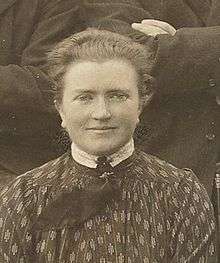Janet Lane-Claypon
| Janet Lane-Claypon | |
|---|---|
 Dr. Lane-Claypon in 1907 | |
| Born |
Janet Elizabeth Claypon[1] 3 February 1877[2] Boston, Lincolnshire, England |
| Died |
17 July 1967 (aged 90) Seaford, East Sussex, England |
| Spouse(s) |
Sir Edward Rodolph Forber (m. 1929; his death 1960) |
| Medical career | |
| Profession | Doctor |
| Specialism | Physician |
| Research | Epidemiology |
Janet Elizabeth Lane-Claypon, Lady Forber JP (3 February 1877 – 17 July 1967) was an English physician. She was one of the founders of the science of epidemiology, pioneering the use of cohort studies and case-control studies.[3]
Early life and education
Lane-Claypon was born Janet Elizabeth Claypon in 1877 into an affluent family, in Boston, Lincolnshire, the daughter of William Ward Lane-Claypon, a banker and former first-class cricketer, and Edith (née Stow). Her uncle C. G. Lane was also a first-class cricketer.[4] A few weeks after her birth, her father changed the family name to Lane-Claypon by royal licence.[5]
She was privately educated and entered the London School of Medicine for Women in 1898. She won various honours and fellowships. She earned both an MD and PhD (making her an early example of the "Doctor-doctor" phenomenon).[6]
Career
In 1912, Lane-Claypon published a ground-breaking study of two cohorts (groups) of babies, fed cow's milk and breast milk respectively. Lane-Claypon found that those babies fed breast milk gained more weight, and she used statistical methods to show that the difference was unlikely to occur by fluke alone. She also investigated whether something other than the type of milk could account for the difference, an effect known as confounding.[6]
Having demonstrated the power of cohort studies, Lane-Claypon went on to develop another key type of epidemiological investigation, the case-control study.
Lane-Claypon tracked down 500 women with a history of breast cancer – the "cases" – and compared them with 500 women who were free of the disease but otherwise broadly similar, known as "controls".
She showed that breast cancer risk increased for childless women, women who married later than average, and women who did not breast feed. The overall breast cancer risk decreased according to the number of children. For all cases, rapid treatment held the key to survival among women with breast cancer.
Personal life
In 1929, Lane-Claypon married civil servant Sir Edward Rodolph Forber (1878–1960), as his second wife. Forber held several prominent positions, including Deputy Secretary of the Ministry of Health. Lane-Claypon's final paper was published under her married name, and she essentially retired following her marriage, not uncommon for a woman of her class in this era.[6]
Lady Forber died in 1967, aged 90.
References
- ↑ England & Wales, Civil Registration Birth Index, 1837-1915
- ↑ "Obituary: Lady Forber, D.SC., M.D." (PDF). British Medical Journal: 314. 29 July 1967. doi:10.1136/bmj.3.5560.313. Retrieved 28 July 2017.
- ↑ Winkelstein, Warren (15 July 2004). "Vignettes of the History of Epidemiology: Three Firsts by Janet Elizabeth Lane-Claypon". American Journal of Epidemiology. 160 (2): 97–101. doi:10.1093/aje/kwh185. ISSN 0002-9262.
- ↑ Law, Cheryl (2000). Women, A Modern Political Dictionary. I.B.Tauris. p. 92. ISBN 9781860645020. Retrieved 28 July 2017.
- ↑ "No. 24433". The London Gazette. 13 March 1877. p. 2026.
- 1 2 3 Ogilvie, Marilyn; Harvey, Joy (2003). The Biographical Dictionary of Women in Science: Pioneering Lives From Ancient Times to the Mid-20th Century. Routledge. pp. 39–40. ISBN 9781135963439. Retrieved 28 July 2017.
External links
| Library resources about Janet Lane-Claypon |
| By Janet Lane-Claypon |
|---|
- Ellen Leopold, Warren Winkelstein Jr.. BCA Newsletter #81. Unsung Heroines: Unveiling History: Janet Elizabeth Lane-Claypon; May/June 2004 [archived 2007-09-27].